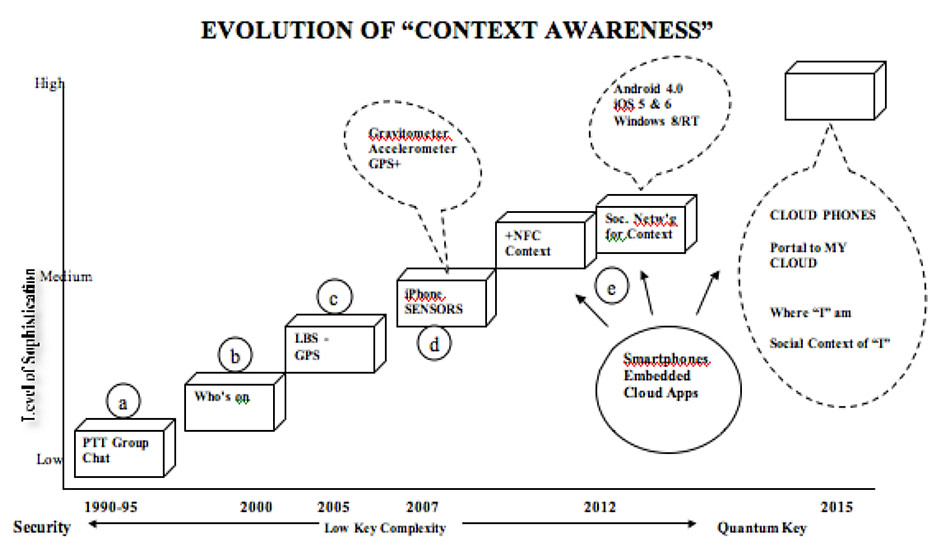The evolution of mobile cloud apps involves the advancement and combinations of a number of disciplines in which we include
- Search
- Social Networking
- Context Awareness
- Device Evolution and Sensors
- Transcendent Software Developments or Capabilities (e.g., Voice Recognition, Augmented Reality)
In this commentary we are primarily interested in the evolution of Context Awareness and its relationship to Device Evolution and Sensors.
Context awareness in telecom started with fairly simple concepts, such as “presence.” In the push-to-talk era, this meant that you could tell if a person was, for example, on the system, on their phone, scheduled for a call, and the like. It should be noted that these were basically “phone” oriented indicators.
With the mobile era, context awareness blossoms out in a number of directions, which revolve primarily around the expanding functionality of the mobile device. This expansion includes initially a number of capabilities of the phone that are concerned with the phone/user’s interaction with the outside world, such as camera and GIS (geographic information system).
In addition, there are sensors that are immediate to the phone, the user and the user’s actions. These may include: accelerometer, gyroscope, magnetometer, altimeter and others.
The analysis of context and context awareness expanded greatly beginning about 2000. There was a good deal of discussion of how to define “context” and as mobile devices proliferated, there were many efforts at definitions.
Personal Situation
Context most obviously includes: location, where the person is. It also includes: actions, what the person is doing.
Environmental Context
Place: The nature of the place, as opposed to just its location
Group: Are others present, if so, who else
Action: What is happening there
Personal Background Information
Context could probably be limited to the above. However, it then would not take into account a lot of information about the person, which is available on computers and other media such as the web, for example, their calendar, their social network.
Intentions
Probably the most subtle aspect of context, or perhaps the ultimate conclusion which “context awareness” is driving at is: intentions or desires – what is it the individual wants to accomplish.
Some have resolved the definitional matter by simply including all elements of the “environment”: and have the defined the environment to include the individual, all information about the individual and any resources available to that user: processors, devices, networks, etc.
One example, (from a Georgia Tech paper in 2001) was:
Context: any information that can be used to characterize the situation of entities (i.e. whether a person, place or object) that are considered relevant to the interaction between a user and an application, including the user and the application themselves. Context is typically the location, identity and state of people, groups and computational and physical objects.
The following diagram tracks the evolution of context awareness as related to and reflected in, mobile device development from 1990, (the early days of push-to-talk) projected to 2015 (cloud phones).
[lightbox type=”image” src=”https://www.mobilecloudera.com/wp-content/uploads/2013/05/context-aware.jpg”] [/lightbox]
[/lightbox]
The diagram indicates a general measure of sophistication along the vertical axis and the date line along the horizontal axis. It also shows the evolution of security features below the date line.
The notes, indicated by the letters, a-e, in circles are as follows:
a. 1990-1995: PTT – Push-to-talk, GSM-based feature, promoted by Nextel
b. Late 1990s early 2000s: “Presence” – who is on line, Nextel/Motorola feature via IP-centric network
c. By 2005: Common use of location-based, GPS chip in feature/smartphones
d. 2007: The iPhone. Situational sensors: up/down, constant velocity, changes in velocity. iPhone chipsets, included gravitometers
e. Late 2000s to 2012: Smartphone/feature phones with cloud apps (PaaS, SaaS) embedded. Twitter, Facebook, storage, services (device OEM) plus NFC – near field communications.
By 2015, we expect to see basically “cloud phones,” or, perhaps more appropriately “cloud devices” that are largely used as portals to “my cloud” and begin to incorporate a considerable amount of contextual capability.
The Security line indicates a progression from simple security, (e.g., a personal datapoint such as an ID number, location address or passwords – key words or phrases) to a complex set of features, including personal choices or data and biometrics (such as facial recognition, iris or fingerprint recognition) as well as voice identification or quantum key cryptography.
We can look at the work in advancing the practicality and usefulness of context awareness in three steps. First, there are immediate attempts to develop the uses of information derivable from the sensors themselves.
Second, there are efforts to use sensor-based information in conjunction with other functionalities. It is in this area that we begin to see the convergence of Search, Social Networking and Context Awareness.
In the third step we will see the further confluence of Context Aware information, Search and Social Networking with what we label the Transcendent Software Technologies, of which Voice Recognition and Augmented Reality (AR) are two of the most prominent examples.
